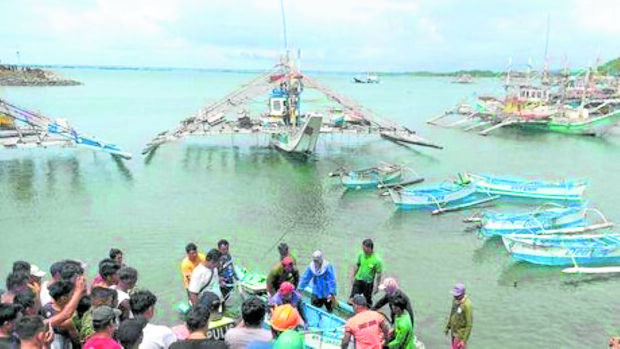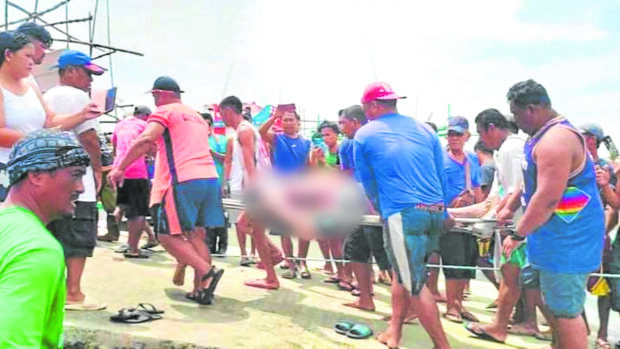Marcos vows justice for 3 killed in WPS boat ramming

PANATAG TRAGEDY Of the 14 fishermen who went out to sea aboard the Dearyn early Monday, only 11 returned alive after a foreign vessel rammed it without stopping, says the Philippine Coast Guard (PCG). —PCG PHOTO
DAGUPAN CITY — Before the break of dawn on Monday, some 305 kilometers off Pangasinan province in the West Philippine Sea (WPS), Junny Manlolo, 40, was on his fishing boat Dearyn angling for squid that he hoped to use later for bait when the vessel suddenly started to pitch and roll.
“It started to rain around 4:20 a.m. so I stood up to [take cover]. But suddenly I felt the boat shake, and I stumbled. Then our boat slowly capsized,” recalled the fisherman from Subic town in Zambales.
The anchored boat had been rammed by a large vessel, later identified by the Philippine Coast Guard (PCG) as the crude oil tanker Pacific Anna, based on the fishermen’s accounts and maritime traffic records at the time of the accident.
Three fishermen, including the captain of the Dearyn, died in the collision that occurred near Panatag Shoal, also known as Scarborough, or Bajo de Masinloc, a traditional fishing ground within the Philippines’ 370-km exclusive economic zone that has been under China’s control since 2012.
President Marcos on Wednesday assured justice for the victims: the captain, Dexter Laudencia, 47; and his two crewmen, Romeo Mejeco, 38, and Benedicto Olandria, 62.
Article continues after this advertisementIn a statement, President Ferdinand “Bongbong” Marcos Jr. said he was “deeply saddened” by their deaths and vowed to extend assistance to the victims’ families.
Article continues after this advertisementHe appealed to the public not to spread unfounded rumors about the incident. Panatag is one of the sites of recurring tensions in the West Philippine Sea between Philippine and Chinese vessels.
“We assure the victims, their families and everyone that we will exert every effort to hold accountable those who are responsible for this unfortunate maritime incident,” he said on his social media accounts.
“Let us allow the PCG to do its job and investigate, and let us refrain from engaging in speculation in the meantime,” Marcos said.
In a statement, the PCG said its initial investigation had pointed to Pacific Anna, a 44-meter tanker registered under the flag of Marshall Islands, saying its movement “aligns with the details provided by the fishermen … after a thorough check on marine traffic.”
“The PCG will reach out to the flag of the vessel and the next port to be visited by the said vessel to be boarded by the Port State Control Officers,” it said. “The PCG is committed to ensuring a thorough and impartial investigation into this tragic incident.”
Bound for Singapore
A marine traffic video provided by the PCG showed Pacific Anna traveling southwest in the waters near Panatag and passing through the stationary Dearyn.
Based on its available automatic identification system data, Pacific Anna left the port of Incheon in South Korea on Sept. 27 and was due to arrive in Singapore on Oct. 5.
A search by Inquirer Research of shipping websites as well as the insurance underwriter Steamship Mutual indicated that Pacific Anna is owned by Compass Shipping 38 Corp. Ltd., a company registered in Hong Kong. But the vessel is being managed and operated by the South Korea-based Sinokor Maritime Co. Ltd., based on publicly available information.
All three victims were from Barangay Calapandayan, a fishing village in Subic town.
The 11 survivors used their small service boats to transport their bodies, as the mother boat had sustained significant damage.Interviewed by phone, Manlolo said he dove into the water after the ramming and banged his fist on the capsized boat, shouting for the other members of the 14-man crew.
Trapped inside the boat, Mandy An, the machinist, hollered for help.
“I was having a hard time finding him since it was still dark and raining,” Manlolo recalled, until another worker, Reymark Bautista, risked his life by diving and pulling An from the engine room.
But it was too late to rescue the captain and two other crew members, he said.
Manlolo, An and Bautista said they were “helpless” as they sat at the boat’s hull, waiting for their other companions who were still fishing some 20 km away.
Four hours later, eight service boats started cruising toward them, and Manlolo said he knew help was on the way.

The bodies of the three victims are brought to shore on Tuesday in Infanta, Pangasinan. —PCG PHOTO
‘Shocked’
Darwin Mejia, 35, said he and the other workers were worried sick when they saw from a distance that only the mother boat’s hull was jutting out of the water.
“We were shocked. We didn’t know that our mother boat was rammed by a passing vessel,” Mejia said.
It was his group that dove into the water to retrieve the bodies of their three companions from the boat.
They brought the remains to the shore of Barangay Cato in Infanta town, Pangasinan, the closest land area, taking almost 12 hours to get there.
“We can’t just leave our dead companions behind. They have families waiting for them,” said Mejia, 35, who had been working with the captain since he was 15.
In its report, the PCG confirmed that Dearyn’s crew had not seen the tanker coming.
“Due to the adverse weather conditions causing darkness, the crew on board the mother boat failed to detect an unidentified vessel approaching, resulting in a collision that caused the mother boat to capsize,” it said.
Before the accident, eight of the crew members were fishing in different areas in their smaller service boats, while six others, including the captain, had remained on the mother boat.
The fishermen were using “payao,” a type of fishing device made of hooks attached to a sturdy rope that can be lowered as deep as 1,500 meters under the sea.
A buoy is attached to the top end of the line to mark its location for fishermen. Most payaos in the Philippines are anchored to the sea floor.
Payaos help in increasing the catch and income of marginalized fishermen, who traditionally use handheld lines and nets for catching tuna and other fish.
Tensions around those waters have recently flared up between Manila and Beijing after the Philippines said it removed a 300-meter ball-buoy barrier installed by China’s coast guard near the shoal, a prime fishing spot and one of Asia’s most contested maritime features.
A 2016 arbitral ruling has upheld the Philippines’ sovereign rights to fish and exploit resources in the area, a decision China has refused to acknowledge.
China has maintained a constant presence of coast guard ships and fishing trawlers in the area.